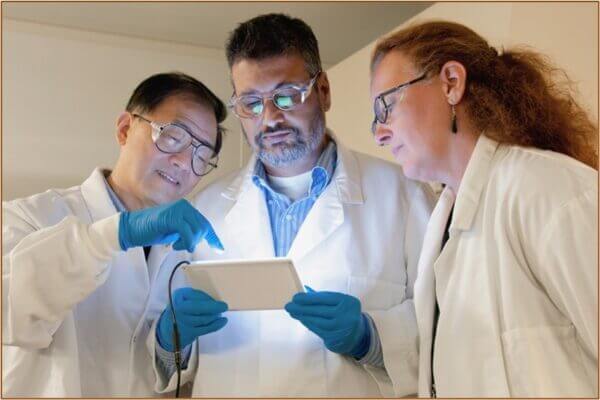
Since its outbreak in the spring of 2020, the COVID-19 pandemic has dominated social, political, and academic discourse around the globe. In a situation of this kind, communication is of particular importance, especially when it comes to health-related information. Due to its dynamics, threat, and impact, the pandemic provides vast opportunities to reflect on the flow of information between scientists and the public. Scientists are expected to advise the public about pressing issues of health and safety, but the demand for easy explanations and quick answers can be challenging and may even conflict with the public’s expectations, wants, and needs.
Tweets like “The vaccine is SOFTWARE” or “They’re trashing your body” were commonplace in discussions about COVID-19 vaccines, revealing a growing mistrust of vaccines and the credibility of experts. The mRNA vaccine, in particular, was unfamiliar to the general public and widely misunderstood due in part to the widespread circulation of misinformation. In the mRNA vaccine, lipid nanoparticles perform the function of coating the drug and facilitating it to cross cell membranes without being degraded in the process. The field of nanoscience can seem daunting at first glance because most people are unfamiliar with the discipline and likely have not had encountered it in their everyday lives (Kisby, 2021). Yet suddenly, it became unavoidable – and that was unsettling. During the pandemic, large parts of society were therefore characterized by a fear of the unknown and the complex. The public was looking for clear, coherent, and simple explanations to be provided by scientists. Particularly in areas that far exceeded scopes of common knowledge and imagination, society was dependent on the data given to them by experts in order to make key decisions about their health. What the public needed most from scientists was expert information to guide them in developing a COVID-related risk assessment based on the latest available evidence and to keep it constantly updated (Lasser, 2020). Considering scientists’ general position as experts in their respective fields, many citizens believe they have a responsibility to transparently handle and share all of the information they have gathered (Lasser, 2020). During the pandemic, they alone had the overview and expertise needed to inform the public about, for instance, whether nanoparticles in vaccines pose a risk, how they work, and why they are used.
In addition to the expectations of the public, scientists’ also view the communication of results to a broad civil audience as a central part of their role and one of the ways in which they measure their success (Dudo et al., 2014). The fundamental aim of science communication is to inform society about research findings and, at the same time, to engage in a dialogue about these issues by connecting academia and the public (World Health Organization, 2022). Scientists’ communication activities can occur either through personal and direct contact with the public or through media professionals. If journalists are involved, they may act as mediators, translating scientific findings into accessible information and presenting them in a way that is suitable to the broader audience.
What needed to be balanced on the part of the scientists, in this case, was how much information was helpful and at what point a level of overwhelm was reached with the complexity of the information. The resulting challenge was to put complicated scientific processes and concepts into understandable words to clarify without causing more confusion. Further, the high demand for constant results and updates, coupled with the highest standards of correctness and accuracy, posed significant challenges for scientists during the pandemic (Lasser, 2020). Mastering these challenges was particularly important since COVID caused uncertainty in both the scientific and public realms, which became a persistent factor that had to be considered and countered in communication (Wald et al., 2022; World Health Organization, 2022). New findings were constantly being made, while old ones were discarded or expanded upon. Overall, the state of knowledge was subject to rapid change, which scientists had to reflect accurately to the best of their ability.
Within the exceptional emergency state of a pandemic and infodemic occurring simultaneously, the public was demanding a bidirectional process of science communication and wanted to be heard (World Health Organization, 2022). This became especially evident in responses to errors resulting from the only feasible strategy in scientific operations during COVID-19: trial and error. Accepting that progress is only possible if previous knowledge is developed and falsified is of central importance here (World Health Organization, 2022). Gaining this understanding is a process that takes place to different degrees and at different speeds in society, making the procedure of science communication incredibly complex. In addition, doubt is part of the scientific process. Findings are probabilistic, which makes declarations of certainty near impossible. For example, some doubts arose among scientists due to the occurrence of inflammation when testing the vaccine with nanoparticles on mice (Ndeupen et al., 2021). When doubt is communicated to the public, uncertainty can be viewed as lack of conviction, which can erode trust. Maintaining trust in the work of scientists and the credibility of science is critical to keeping the public informed and effectively counteracting misinformation (World Health Organization, 2022).
In an ideal world, it would have been best if scientists were able to put this complex topic into understandable, reassuring, and, above all, thoroughly positive terms then serve them up in bite-sized form. But this ideal world does not exist. In reality, communicating science is a complex procedure that was both praised and heavily criticized by society and experts in times of the pandemic. Critical voices even spoke of a failure in the context of science communication within COVID, which lacked target group orientation (Hira, 2021). The public accordingly found itself in the challenging position of having to continually adjust its knowledge about the pandemic on the basis of new, changing, and contingent information from scientists. The public was seeking access to science that researchers were willing to provide. However, three central questions seemed to pose a challenge in this process: (1) How much information should be communicated, and to what extent?; (2) How can complexity be reduced appropriately to enable comprehensibility and avoid confusion where possible?; (3) How can the already complex profession of researcher be combined with the great responsibility of simultaneously fulfilling the communicator position in a global exceptional situation such as COVID-19?
While scientists were already under high pressure to conduct research throughout the pandemic, they faced a public for whom these research results were more important than ever before because it was key health information that could have life or death consequences. On one hand, it can be argued that high public expectations of scientists in communicating about the pandemic are justified because this aspect has become part of their professional role and self-definition. They are the only ones who can provide the information needed. On the other hand, it could be argued that too much responsibility was placed on scientists in this exceptional situation, as the acquisition of information in the course of research alone was an unparalleled challenge under these extreme conditions. Both sides have legitimate concerns, and an ethical examination requires balancing the interests of scientists and the public – something that should not be underestimated in terms of complexity. It may require reconciling or aligning conflicting expectations and behaviors on both sides.
Discussion Questions:
- In scientific communication on nanotechnology during the COVID-19 vaccine debate, a major challenge was to reduce complexity. Should information be greatly simplified to encourage potentially life-saving compliance, or does this deny interested citizens the chance to become more deeply informed?
- Is it justified for society to expect that scientists are not only experts in research on their complex topics of interest but also skilled communicators, especially considering that communication is a profession of its own?
- Could journalistic translation work temporarily take over the communicative activities of scientists in the case of another exceptional situation of this magnitude, or would this be problematic? If so, to what extent?
- In times of tremendous pressure, scientists might feel compelled to prioritize their scientific work and make communication a secondary priority. Find arguments for and against this decision, taking into account the two sides of the issue addressed in this study.
Further Information:
Dudo, A., Kahlor, L., Abi Ghannam, N., Lazard, A., & Liang, M. (2014). “An analysis of nanoscientists as public communicators. ” Nature Nanotechnology, 9. Available at: https://doi.org/10.1038/NNANO.2014.194
Hira, A. (2021). “The tragic failure of science communication- From climate change to COVID.” CSPC. Available at: https://sciencepolicy.ca/posts/the-tragic-failure-of-science-communication-from-climate-change-to-covid/
Kisby, T., Yilmazer, A., & Kostarelos, K. (2021). “Reasons for success and lessons learnt from nanoscale vaccines against COVID-19.” Nature Nanotechnology, 16. Available at: https://www.nature.com/articles/s41565-021-00946-9
Lasser, J., Ahne, V., Heiler, G., Klimek, P., Metzler, H., Reisch, T., Sprenger, M., Thurner, S., & Sorger, J. (2020). “Complexity, transparency and time pressure: Practical insights into science communication in times of crisis.” Journal of Science Communication, 19(05), N01. Available at: https://doi.org/10.22323/2.19050801
Ndeupen, S., Qin, Z., Jacobsen, S., Bouteau, A., Estanbouli, H., & Igyártó, B. Z. (2021, December). “The mRNA-LNP platform’s lipid nanoparticle component used in preclinical vaccine studies is highly inflammatory. ” IScience, 24(12), 103479. Available at: https://doi.org/10.1016/j.isci.2021.103479
Wald, D. M., Carvalho, A., & Felt, U. (11 May 2022). “Editorial: Science in a Time of Crisis: Communication, Engagement and the Lived Experience of the COVID-19 Pandemic.” Frontiers in Communication, 7. Available at: https://doi.org/10.3389/fcomm.2022.920619
World Health Organization. (19 April 2022). “WHO global conference on communicating science during health emergencies.” Available at: https://www.who.int/publications/i/item/9789240044760
Authors:
Finja I. Augsburg, Leah A. Ransom, & Scott R. Stroud, Ph.D.
Media Ethics Initiative
Center for Media Engagement
University of Texas at Austin
February 21, 2024
Image by National Cancer Institute on Unsplash
Cases produced by the Media Ethics Initiative remain the intellectual property of the Media Ethics Initiative and the Center for Media Engagement. This case was supported by funding from the John S. and James L. Knight Foundation. This case can be used in unmodified PDF form in classroom or educational settings. For use in publications such as textbooks, readers, and other works, please contact the Center for Media Engagement.
Ethics Case Study © 2024 by Center for Media Engagement is licensed under CC BY-NC-SA 4.0




